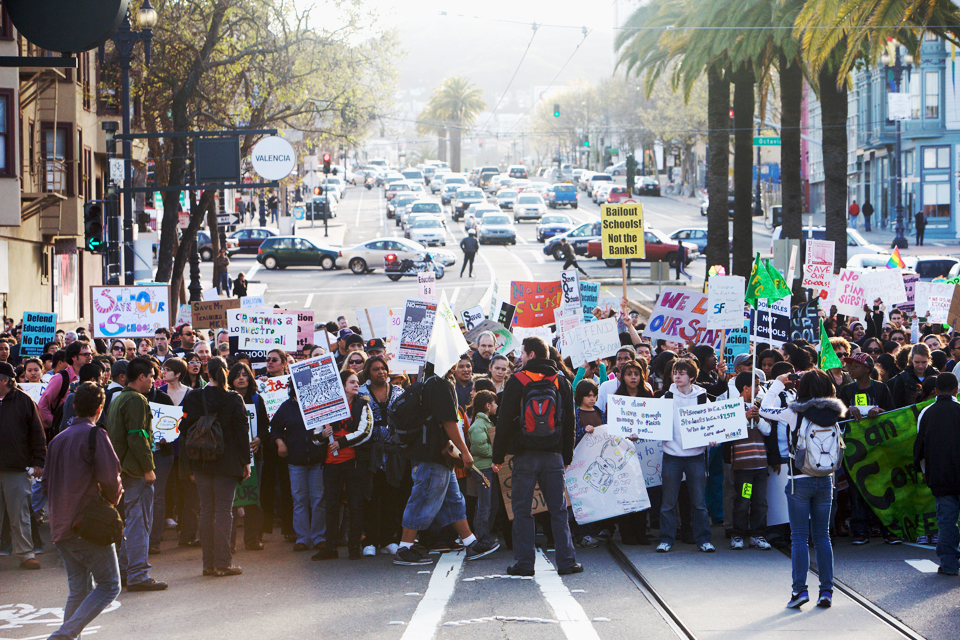Even as classes began last week for San Francisco’s 55,000 public school students, nearly 50 teachers and other staff remained out of a job as the school district struggled to find openings to rehire them after a summer of budget cutting.
Previously laid-off staff continued to get recall notices, with the most recent rehires announced Thursday.
The majority of recalls were made in the last month. Still, eight teachers and 40 paraprofessionals remained laid off.
While the student-teacher ratio remains unchanged, many paraprofessional jobs, such as teaching aides and parent liaisons, have not been restored. In addition, 113 paraprofessionals have had their hours reduced.
Union officials and parents said the practice of laying off staff and then rehiring them as late as the first week of school is disruptive of education. They also said the loss of paraprofessionals hurts the schools’ efforts at diversity because they are more likely than teachers to be ethnic minorities.
In the face of a projected $113 million two-year budget deficit, last March the San Francisco Unified School District issued 701 pink slips, notifying teachers that they would not be guaranteed employment for the next school year. The understanding was that the district and the teachers’ union would work before school started for the fall semester to restore some or all of those jobs.
As of May, following negotiations with the district’s labor unions, 218 teachers were still on the layoff list, and 277 paraprofessionals either lost their jobs or had reduced hours.
District officials were able to whittle away at that list over the summer, as others retired or quit, and financial projections at some schools changed. The layoffs list also shrunk as some employees found work elsewhere, rather than waiting a recall over the summer.
To date, the district offered to recall 213 teachers. Of these, 15 to 20 resigned and one retired.
But the district also found the need to fill some jobs with new people — between 100 and 120 new teachers were hired. These were, for the most part, specialists in bilingual education, math and science.
The eight teacher layoffs as of last week included three art teachers, two nurses, one computer teacher, one Mandarin teacher and one peer-resources teacher.
To avoid layoffs, the district offered retirement incentives of $4,300 to staff who had not been laid off. The district also maintained health benefits over the summer for those who agreed not to return for the next school year.
“It’s a constantly changing field,” said Tom Ruiz, senior executive director of labor relations at the school district. “The original number was based on $113 million budget deficit. Then we reached settlement agreements, which took that number down.”
Issuing more layoff notices than ultimately necessary complicates the situation for staff, he said: “Some teachers can’t afford to wait to see if you’re going to call them back or not. Some already have another job.”
Union without a say
The United Educators of San Francisco, the teachers’ union representing about 4,000 teachers, negotiated with the district over layoffs, getting the list down to 218. But after May, it was not involved in the process of recalling staff to work.
“The way in which the district has decided to rescind the layoffs is known only to them,” union spokesman Matthew Hardy said. “They have a kind of magic eight ball. Our representative couldn’t make heads or tails as to why they’ve decided to do it the way they have.”
The district was unable to confirm exactly how many teachers it currently employs.
“I don’t have the exact number,” Ruiz said. “It’s lower than last year. We can’t say until the second payroll run on Sept. 30.”
The practice of distributing layoffs notices and then recalling many has come under criticism from the union.
While “ecstatic” that many of the layoffs had been recalled, Albert Ko, president of the San Francisco Parent Teacher Association, said the situation caused much concern among parents and students.
“Some parents were adamantly opposed to laying off teachers, some parents adamantly opposed to increasing class sizes,” said Ellie Rossiter, director of Parents for Public Schools–San Francisco. “No one is happy about furlough days, but we didn’t have a lot of options given the shortage of dollars.”
Prepared for anything
As soon as the district is aware of an opening at a school, a laid-off teacher is recalled — and expected to start work immediately.
This ad-hoc process has proved workable, said Angie Sagastume, executive director of staffing for the district: “We had a very smooth school opening. There were only 1.8 vacancies.”
Despite the last-minute nature of many of the recalls, Hardy maintains that teachers do not go into the classroom unprepared. “Our folks are professionals,” he said. “They’re ready to go on day one.”
The loss of paraprofessionals and reduction of their hours might be a problem. For example, fewer people in the district now work on truancy.
Sagastume was keen to stress that although a school may have lost all paraprofessionals working in a particular area, their loss will have made room to keep a more senior paraprofessional “to serve the students” — even if they are doing a different job.
Staff diversity is another sticking point. While the district’s students are ethnically very diverse, they are underrepresented among teachers.
Ethnic minorities made up 84.4 percent of the student population in the 2008-2009 school year but only 19.3 percent of teachers. Paraprofessionals, including teachers’ aides and parent liaisons, are typically more diverse. In 2008-2009, 57.1 percent belonged to ethnic minorities.
Hardy said this makes paraprofessionals important in making connections with students. “The district has made such a big deal about closing the achievement gap,” he said. “We feel strongly that the paraprofessionals are a direct link to those goals.”
Both paraprofessionals and teachers have the same recall rights, and can stay on the rehire list, awaiting the possibility of being rehired by the district, for up to 39 months.









